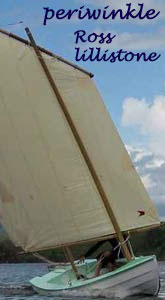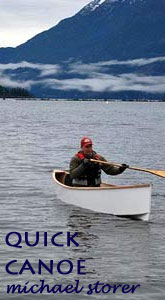
 Custom Search
|
| boat plans |
| canoe/kayak |
| electrical |
| epoxy/supplies |
| fasteners |
| gear |
| gift certificates |
| hardware |
| hatches/deckplates |
| paint/varnish |
| rope/line |
| rowing/sculling |
| sailmaking |
| sails |
| tools |
| join |
| home |
| indexes |
| classifieds |
| calendar |
| archives |
| about |
| links |
| Join Duckworks Get free newsletter CLICK HERE |
|
|
| Stirring the Epoxy Encapsulation Pot - Part Two |
by Michael Storer - Adelaide, South Australia - Australia |
Part One - Part Two - Part Three
With regard to other materials for building ... I'm not putting them down at all. The "stirring of the pot" was more in the nature of whether epoxy works as they say. If a quality epoxy (no thinners) and applied properly by a caring amateur builder (as a starting standard) it is very effective. As far as the other building materials for gluing and coating... Like I said, I started off pretty well in the non epoxy plywood dinghy building days in Australia. Then I was grudgingly converted to epoxy by working with so many boats and customers and seeing it really worked compared to the previous alternatives. At one point I would have pretty well said that building of anything that is not epoxy is a waste of time. But I've moderated from that position. The last part of the story has been the success of primarily USA and Canadian builders showing me the value of PL Premium and SOME of the other alternative glues and there's even a place for latex paint. For gluing alone of our size of boat, epoxy is still in there because of its gap filling properties. It does make a much more fail safe option. FAILURES Failures are interesting. They are strongly statistical in nature, which is why I dwell on big numbers of boats ... broad experience. It's not special to me - people who race plywood dinghies or catamarans share their experience - and all the boats are similar enough in construction and use that you can see the weak points of methods and materials. Like hydrofoiling moths ... Theres a few odd hydrofoil boats every decade that perform in one direction only or are expensive, but it took Australian Foiling Moths racing every weekend and once of twice through the week to make it truly feasible in all directions at reasonable cost (at least initially). At the beginning they woudn't fly in less than about 8 or 10 knots of breeze, so they would shoot ahead in little gusts and then the fleet would catch up again. Now they can takeoff in about 5 or 6 knots or supernaturally keep foilborne in 2 or 3 knots of breeze if they are up already. Week by week, numbers and sharing information. Working in boatbuilding and restoration - I've always got a raft of questions and have huge respect for someone that uses a range of materials. Florida builder and designer Paul Ricelli is a big favourite of mine - he knows more about alternative materials than anyone. Of course you occasionally run into the odd reactionary in the field that will say epoxy is the devil's work (on some very occasional days I would agree) but usually they are very anti scientific too and are well behind the experience and information curve. So ... how do I know polyester resin is inferior? Because of collected experience on racing dinghies and the number of people that end up reglassing seams or advertisments for used vessels saying "dry boat" (ie no leaks). Never a question with epoxy ... the boat almost certainly won't leak ... and is unlikely to start to leak. But "dry boat" referring to polyester/glass seams means that some boats built of alternative materials do very well indeed and others don't. But the strange thing is even though extra care and skill goes a long way ... it doesn't ensure a consistent product in the same way. That's also my experience with polyester repairs. Sometimes it will stick like Hades, other times you can tease up a corner and pull a whole sheet off a deck. Sometimes you have sticking and non sticking in the one job! Back in the days when I was involved in PDRacers a couple of serial builders found that the real costs of using epoxy as the glue only. The costs are very competitive with the real costs of alternatives. But I've changed my cheap range of plans - the OzRacer and derivatives and the Quick Canoe standard and Electric to mention alternative glues and some of the cautions that experience shows makes them work better.
The biggest advantage of alternative glues is that they make it so easy just to "start building". Down to the big box store, get the bits and start the same day. From that point of view, even polyester has some positive points. The other reason is a bit mythic, but it is real. The limitations of alternative glues (close fits, high clamping pressures and some limitations in waterproofness). Alternative glues should really set everyone's mind up to do a very craftsperson like job to minimise the weaknesses. But in reality they engender a much more carefree approach. This is maybe not so good for the longevity of the build, but it does engender a cheerful attitude of enjoying the building. Squirt some goo out of the bottle and screw away. I'm not putting this down ... I actually think it is important to the feeling of success and enjoyment of alternative boatbuilding. People get really excited about it. Compare with the early paragraph I wrote in the previous missal about the stickiness of epoxy and the strongly procedure based work and the somewhat different feeling. There's a lot of satisfaction when the job is finished ... but not such a carefree feeling on the way through. Alternative glues are rightfully very popular in the US and Canada, and not so common elsewhere. There is one reason for that. In Australia to get a very basic exterior ply for a cheap build would start around $50 a sheet for 1/4" or 6mm ply and commonly be around the $70 mark. Real Marine ply is not that much more expensive. Timber prices similarly - most of our woods are hardwoods and lighter timber for home boatbuilding is often imported. Look at prices about 5 to 8 times what you are paying in the USA. You do see exterior ply at around $30 sometimes but it is rare to find a stock of sheets that look vaguely nice. So you have a larger initial investment. The feeling of building a boat to "see how it goes" or building it with the aim of a bonfire a couple of years down the line is totally absent. So there is economic pressure to preserve the investment even if it adds the $150 to $250 of epoxy to the build. We need our boats to last to give value to the higher investment. It is the same in Europe ... or even more so. I'm living much of the year in the Philippines at the moment. Poorer ply just falls apart and there are two or three brands of good local ply. Additionally the crackdown on illegal logging has pushed the price up about 20% in the last year. You might be looking at 15 dollars a sheet. But a middle ranking office worker gets a quarter or less of the income of someone in the USA or Oz so ply is effectively four or many more times more expensive depending on your income. So again epoxy is usually used. Epoxy is actually somewhat cheaper here because of bulk imports from China, same with glass. But finding reliable sources makes groups like www.pinoyboats.org highly useful. Epoxy has a high use rate in the Philippines too. Even for their "Bahanka" project - a square raft boat with 2ft sides and dead flat bottom from 9mm (3/8") ply that doubles as a bed when there aren't floods to deal with. The function there requires maximum reliability despite that it is meant to be a boat for middle and low income earners as well. But, I'm getting off the track. There is a place for alternative glues etc, particularly in North America. And in other countries when cheapish sources of timber and ply are available. |
To comment on Duckworks articles, please visit one of the following:
|
 |




